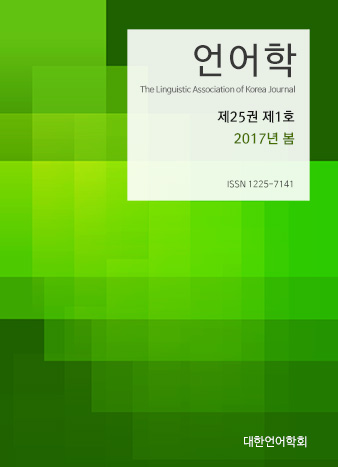대한언어학회 전자저널

-
Why is the Locative NP in Kiswahili not Syntactically Oblique?
-
Developmental Errors in Chinese L1 Speakers’ Use of the L2 English Past Tense and Perfective Aspect
-
An Exploration of High School Reading Test Items Based on Discriminant Analysis
-
Marketization of University Brochures in Korea and the US: From a Genre Analysis Perspective
25권 1호 (2017년 3월)
- On Corrective Stripping in English
-
Myung-Kwan Park
Pages : 117-137
Abstract
Keywords
# corrective ‘fragment’ # TP ellipsis/Stripping # comma coordination # corrective but # island (in)sensitivity # sub-clausal coordination
References
- Barros, M. (2012). A non-repair approach to island sensitivity in contrastive TP ellipsis. In Proceedings of CLS, 48. Chicago: Chicago Linguistic Society.
- Barros, M., Elliott, P. D., & Thoms, G. (2013). More variation in island repair: Clausal vs. non-clausal islands. In Proceedings of CLS, 49. Chicago: Chicago Linguistic Society.
- Barros, M., & Vicente, L. (2016). A remnant condition for ellipsis. In K. Kim et al. (Eds.), Proceedings of the 33rd West Coast Conference on Formal Linguistics (pp. 57-66). Somerville, MA: Cascadilla Proceedings Project.
- Chung, D. (2014). On the locus of the interpretable negative feature in a negative sentence. Language Research, 50(2), 461-486.
- Fernández, R., & Ginzburg, J. (2002). Non-sentential utterances: A corpus study. Traitement automatique des languages, 43(2), 13-42.
- Ginzburg, J., & Sag, I. (2000). Interrogative investigations. Stanford: CSLI Publications.
- Griffiths, J., & Liptak, A. (2014). Contrast and island sensitivity in clausal ellipsis. Syntax, 17(3), 189-234.
- Gruenstein, A. (2002). English corrective fragments: syntactic and semantic considerations. Unpublished Ms., Stanford University.
- Holmberg, A. (2015). The syntax of yes and no. New York: Oxford University Press.
- Kramer, R., & Rawlins, K. (2009). Polarity particles: an ellipsis account. In Proceedings of the 39th Annual Meeting of the North East Linguistic Society (NELS 39). Amherst, MA: Graduate Student Linguistic Association.
- McCawley, J. D. (1991). Contrastive negation and metalinguistic negation. Chicago Linguistic Society (CLS), 27, 189-206.
- Meinunger, A. (1995). Focus relations and weak islands. In J. Camacho, L. Choueiri & M. Watanabe (Eds.), The proceedings of the fourteenth West Coast conference on formal linguistics (pp. 355-349). CSLI: Stanford, California.
- Merchant, J. (2001). The syntax of silence: Sluicing, islands, and the theory of ellipsis. Oxford: Oxford University Press.
- Merchant, J. (2004). Fragments and ellipsis. Linguistics and Philosophy, 27, 661-738.
- Merchant, J. (2008). Variable island repair under ellipsis. In K. Johnson (Ed.), Topics in ellipsis, (pp. 132-153). Cambridge: Cambridge University Press.
- Park, M.-K. (2015). Ways of replying to negative questions in English and Korean. Korean Journal of English Language and Linguistics, 15(3), 397-421.
- Potts, C. (2005). The logic of conventional implicatures. New York: Oxford University Press.
- Roberts, C. (2012/1996). Information structure in discourse: towards an integrated formal theory of pragmatics. Semantics and Pragmatics, 5, 1-69.
- Steindl, U. (2013). Corrective coordination with ‘but’ across languages. A handout read at CGSW 28.
- Toosarvandani, M. (2013). Corrective but coordinates clauses not always but sometimes. Natural Language Linguistic Theory, 31(3), 827-863.
- Vicente, L. (2010). On the syntax of adversative coordination. Natural Language and Linguistic Theory, 28, 381-415.
- de Vries, M. (2002). The syntax of relativization. Ph.D. dissertation, Utrecht University.
- de Vries, M. (2006). The syntax of appositive relativization. Linguistic Inquiry, 37(2), 229-270.
- Weir, A. (2014). Fragments and clausal ellipsis. Doctoral dissertation, University of Massachusetts Amherst.